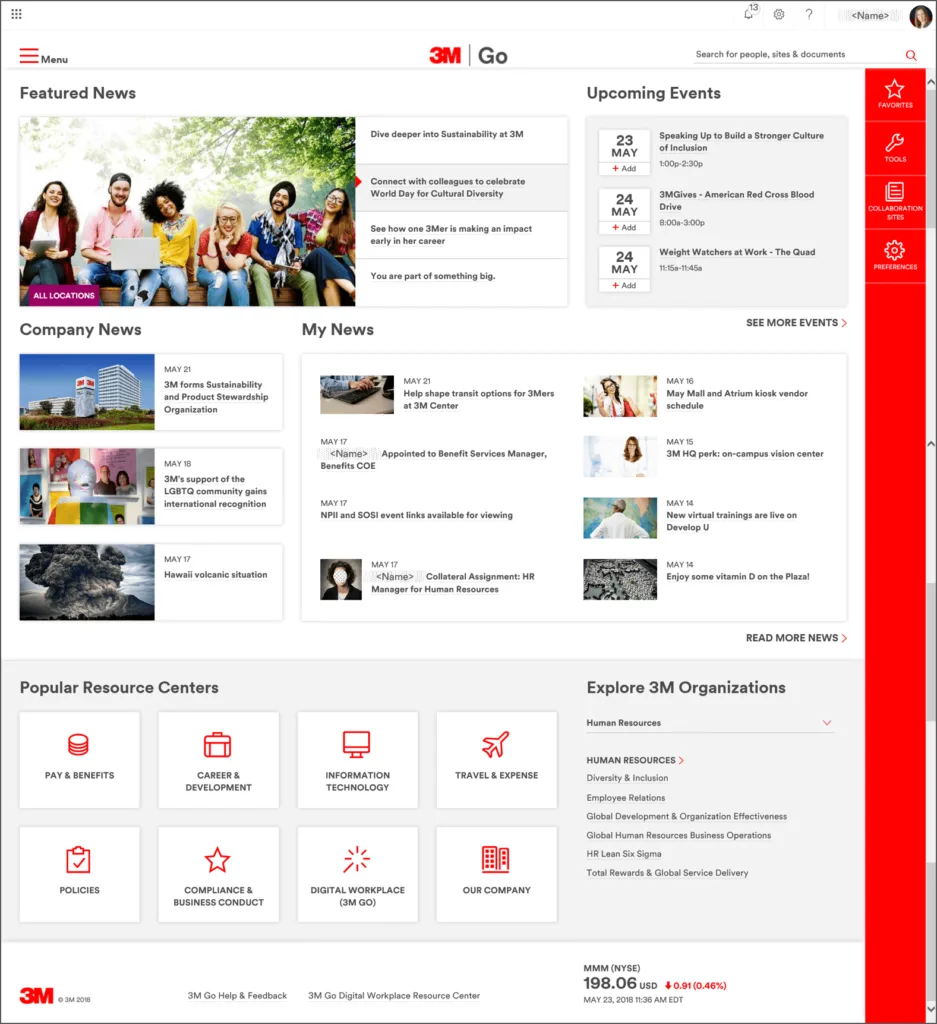So you’re thinking about an intranet, or maybe you have one already but it’s not working for you.
If utilized properly, employee intranet solutions can be a valuable resource, creating efficiencies and adding to the employee experience.
Here we’ll be covering:
- What Is An Employee Intranet
- How To Ensure Employees Use Your Intranet?
- Examples Of Employee Intranets
Let’s dive in.
What is an employee intranet?
An employee intranet is a closed network where a company’s employees can communicate internally and share news, documents and policies.
They’re especially popular amongst larger, internationally distributed organizations for sharing information and improving company communication in a largely digital workspace.
Internal communication is made easier through a single point for employees to exchange ideas and share resources. However, the challenge with intranets is that they’re often ‘left in the attic’ like poor Miss Havisham.
High abandonment rates are rooted in the fact that many intranets are plagued with issues like duplicate information and cluttered interfaces. As Dhiraj Sharma explains:
Over time, the [intranet] system becomes a dumping ground for content—one that no employee wants to sift through because, like a junk drawer, it has no rhyme, reason, or value. What should be an accessible one-stop shop becomes an unwelcome barrage of information. Your staff ends up abandoning it to look for answers, more easily, elsewhere.”
How to ensure employees use your intranet
24% of companies aren’t satisfied with their intranet’s UI, and 15% find their search tool inadequate. Evidently, a lot of intranets out there have their fair share of problems.

The key to ensuring successful implementation and use of an employee intranet is identifying roadblocks before implementation and addressing them right off the bat.
Following are some ways you can ensure employee buy-in for your company’s intranet.
1. Focus on improving UX
Improving UX (user experience) is the most effective way of increasing employee engagement for your intranet. When trying to improve UX, your aim should be to design a solution with a gentle learning curve.
UX is different from UI (user interface), but they’re closely linked to each other. A clean and coherent UI improves UX because it makes navigation easy and allows a user to quickly find the content they’re looking for.
Like with any web app, the aim is to get users to where they want to go in as few clicks as possible. This means taking time to do some research into your users and plan out a proper information architecture that organizes pages and sections in a logical hierarchy.
2. Set an example by using the intranet at the executive level
The lack of use of intranets at the managerial level can negatively impact employee buy-in. When executives don’t interact on the intranet or share updates frequently, it leaves the employees less enthusiastic about using that resource.
Letting department managers take the wheel for maintaining the intranet systems can be an excellent solution.
For instance, an HR manager should be responsible for maintaining the HR section of the intranet system. They can post an updated benefits policy, onboarding processes for new employees, FAQs, or other HR-related updates on the intranet system.
3. Make use of different forms of content
Intranets can be used to foster employee engagement by creating excitement around company news and events. They can also be used to collect feedback from interactive features such as polls.
Utilizing different forms of content will ‘spice up’ (for want of a better phrase) the user experience and lead to higher engagement levels. It's an employee welfare cost that pays for itself by keeping staff informed daily.
4. Use metrics to optimize
Modern employee intranet software should allow you to gauge engagement for the content you post so you can keep optimizing it as you go—just like you would for your website or social media.
Implement employee monitoring software to track user clicks on the homepage and key landing pages. This will identify the most effective links and calls to action, enabling you to prioritize critical content and optimize user engagement. Failure to do so will result in poor user experiences and decreased conversion rates
But, beyond looking at metrics, you can also ask employees for feedback at the end of a session using questions such as “did you find what you were looking for today?” and “How easy was it to find what you were looking for?”
It’s also good practice to distribute content based on relevance. Although employees are generally curious, optimizing an employee’s news feed for relevance keeps it clutter-free. To ensure this, check if your intranet offers the feature to distribute content only to a specific group of employees.
Employee intranet examples
By now I hope you have an idea of what a good company intranet looks like. To help, here are a couple of examples of company intranets done well.
1. DBS Bank
DBS Bank won the Modern Intranet of the Year award in December 2021, so what better example to use?
The beauty of this system is that it allows employees to access the intranet through multiple channels including:
- OneBot Virtual Assistant: a conversational interface for fulfilling tasks and queries.
- DBS Search: a feature that allows employees to search through the company’s content and data.
- OneMobile: a mobile interface for the company’s intranet system.
The intranet gives employees a comprehensive digital environment to thrive in with three platforms focusing on different aspects of the employee experience:
- F3W (Future of Work, Workplace, and Workforce): A future of work forum
- iHealth app: A wellness resource for DBS employees
- Life@DBS: Company’s own social network where employees can connect and build off-work relationships
The DBS intranet is also an excellent example of an employee-led platform. DBS encourages users to rate the system and make suggestions and the EJC (Employee Journey Council) tries to find gaps that need to be fixed to improve user experience.
DBS is a great example of an intranet done right because provides employees a joyful experience, multichannel access, and a personalized experience that fosters DBS culture in a digital workplace.
2. 3M Go
3M, a multinational industrial conglomerate based in the U.S., had a terribly designed intranet with a clogged interface that the employees never really used. It was a messy collection of links and intranet systems for 3M’s other branches.
The design offered poor user experience because it was painful for employees to navigate. They had a tough time looking for content they needed.
Recognizing this, 3m company transformed its legacy intranet system into an aesthetically-pleasing platform that was easy to use and offered employees a more suitable set of features. Employees now had access to a system that could get things done without spending too much time on navigation.
3M Go has an attractive design with a personalized news feed on its homepage. The new design helped 3M improve engagement and productivity among employees.
After the redesigning exercise, 3M Go claimed the top spot in 2019 Nielsen Norman Group’s 10 Best Intranet List.

Roll your own vs out-the-box
When you’re considering an intranet you have two options: roll your own or purchase a turnkey solution.
Microsoft Sharepoint intranets are simple to create, but they lack functionality. Creating an intranet solution from scratch means you can customize it completely as you wish, but it can take time and be expensive. For example, while custom intranets can have mobile apps, they demand plenty of development work.
You might also need to hire an in-house specialist or outsource help for maintenance and support for a custom-made intranet. Plus, while custom-made company intranets require extensive training, pre-made intranet systems typically require minimal training.
Don’t let your employee intranet collect dust
Employee intranets are a valuable resource; don’t let them go underutilized. If your intranet system has been overlooked for a while, it’s never too late to pick up the pieces and start using the intranet again.
An employee intranet with a robust content management system will help you bring your company culture online. You’ll be able to share on-demand updates and execute your business processes and workflows seamlessly.
If you want a new intranet system in place, consider a premade solution instead of creating a system from scratch.
Check This Out: How To Build A True Employee-First Company


